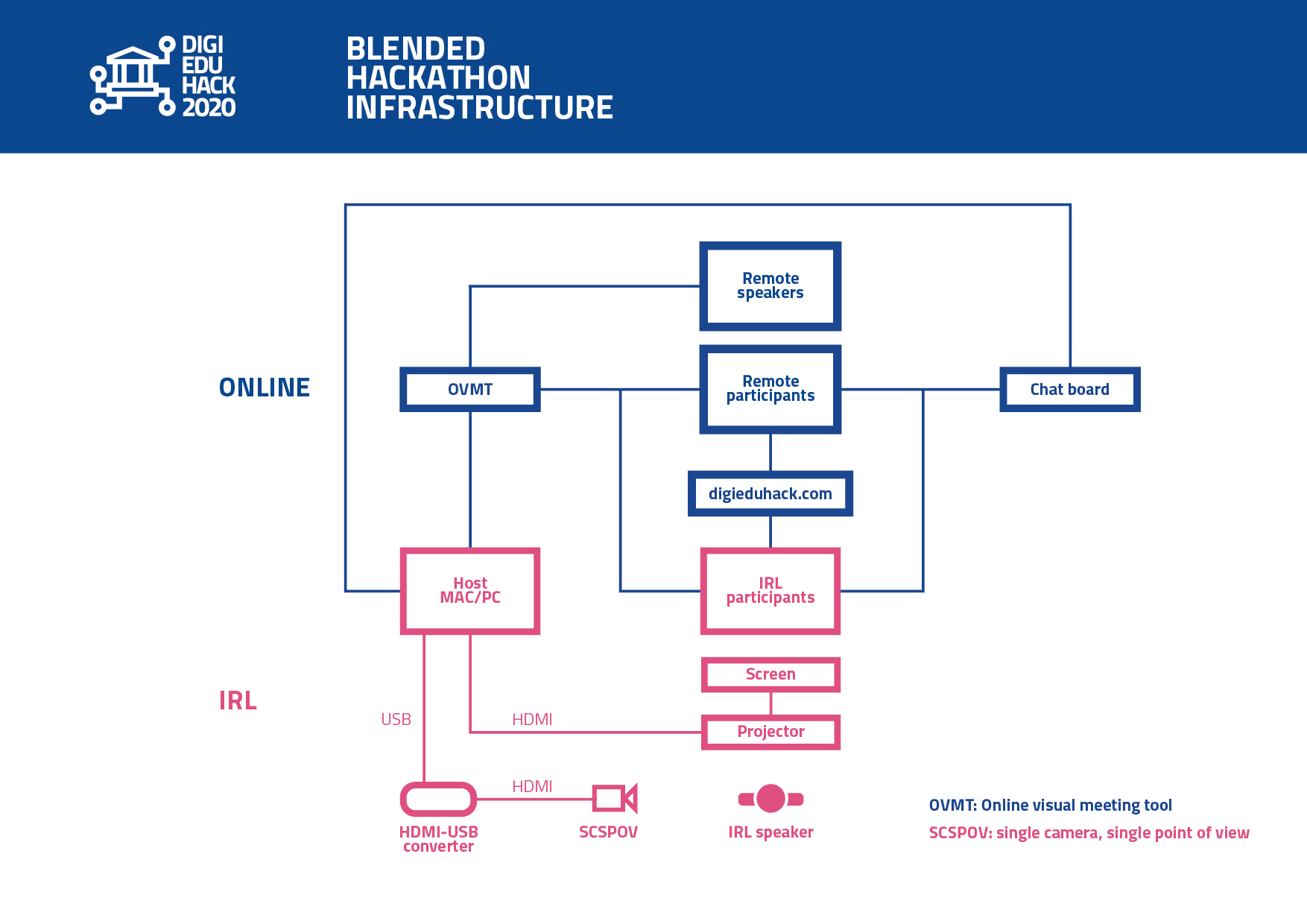DIGIEDUHACK-101: Blended and mixed hackathons
You're still hesitating between an online and an offline DigiEduHack event? This article is for you!
You have been weighing the alternatives between an online and an offline hackathon, but you're still not sure: you love the energy of an offline event but you also want to allow participants from Europe and beyond to join your event. Take a deep breath, we have good news for you: there's a third way! Meet the blended hackathon.
Although not new, the concept of blended hackathons is fairly recent: blended events such as DreamHack or Campus Party already set the trend at the beginning of the 2000s by combining "in-situ LAN parties" with remote participants. Fast forward today, blended hackathons are exactly what they seem to be: events happening both in a physical location with IRL ("In Real Life") participants AND online with online participants. How is this magic made possible? Well, it's not magical, it's technological. Blended hackathons heavily rely on video and available bandwidth to actually deliver.
Why a blended hackathon?
The best way to answer the "why a blended hackathon?" is actually to lay down all the advantages of this type of hackathon. Buckle-up, because there are a lot. The main advantage of the blended hackathon over its offline and online cousins is its inherent broader reach. Because it combines both online and offline possibilities, a blended hackathon will allow more and more diverse participants to take part: to the offline crowd that will be on location, blended hackathons add the (infinite) online crowd. Similarly, a blended hackathon allows you as a host to have a more vast choice of speakers and mentors: some can be physically present while others would be online. A blended hackathon also allows you to create a more engaging event: the group energy at your IRL location can be propagated to your remote participants, creating a more intense dynamic for your whole event. The list could go on forever but you probably already got the point: a blended hackathon is much more versatile than its offline and online counterparts.
The infrastructure
As general advice: the more you add components to your production line, the greater the risk to have a technical failure. so here we're going to have a look at the "most simple setup" for a blended hackathon: single camera-single point of view (SCSPOV), no live jingles/on-screen animations/, your favourite online visual meeting tool (aka OVMT: that's your Zoom, Webex, ...), no live streaming on Youtube or Facebook. Below you will find the diagram created for DigiEduHack 2020, still available for 2021: 
- the SCSPOV camera can be any device with an HDMI output. For image quality purposes, a DSLR with a good lens works the best.
- the IRL screen and projector are needed to display all the remote speakers' interventions to the IRL participants
The drawbacks
Unfortunately, blended hackathons are no miracle solutions to all your host issues. They suffer from two major drawbacks: they are extremely bandwidth-greedy and are not totally inclusive. In a blended hackathon, the link between the online participants and the offline participants is the video: every meetup, every speech, every important moment of your blended hackathon needs to be filmed and broadcast to online participants. And this applies to all stages of your event: let's say that your welcome speech is done IRL. You have to film it IRL with a camera/phone/image capturing device combined with a microphone and broadcast the images and the sound live to your online participants. If your first speaker is online, they have to be filmed and the images broadcast to your offline participants. That implies using at least one camera for the IRL to online audio/video flux, operators, and a solid network in order to avoid lags and delays. This is a bit different from the configuration needed for an online hackathon where you don't need to broadcast (you're using an enclosed system such as Zoom/Meet/Webex/Jitsi/... and no external camera)and where you don't need additional images/sound capture devices (you can use the speaker's own on-board camera/mic).
This also means that blended hackathons require online participants to have access to a solid 4G network that prevents lagging, cuts and interruptions. Although this "network drawback" is not specific to blended hackathons (you can also encounter it in online hackathons), it tends to accentuate the digital divide and might exclude some online participants.
Hello, mixed hackathon!
Rejoice, there is a way to tackle two out the three aforementioned drawbacks: the mixed hackathon will take you closer to the perfect balance between inclusion, tech, and participation. The mixed hackathon is actually a blended hackathon with an added frugal dimension: the use of frugal tech to reach remote participants that rely on 2G, 3G or unstable networks. How does it work? Just like a blended hackathon with one (major) difference: all your happenings are audio-recorded and uploaded on a dedicated platform such as Logamp or FunkWhale for example, in an asynchronous process. Participants with lower broadband can access all the interventions, when they want/can. This removes the "live" constraint and is much more inclusive. You can even go further in your mix: you could even imagine a system where participants who would not have access to an omnichannel chat board would gather in small teams and could use a text to computer service or an instant messaging app to chat with a team captain/mentor located IRL at the hackathon location. Running a hackathon this way would probably be a world premiere. Are you willing to try the experience?
